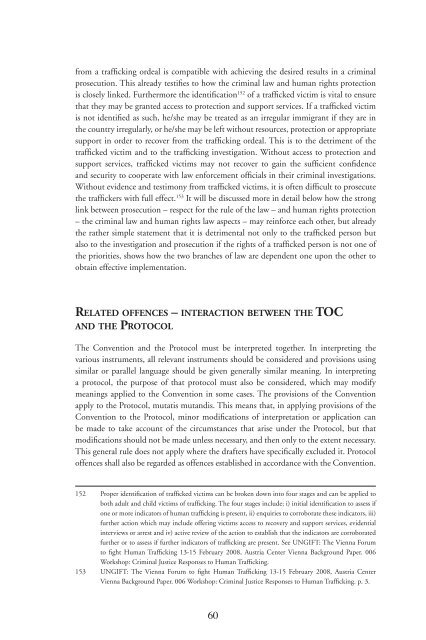Trafficking in human beings: human rights and ... - unesdoc - Unesco
Trafficking in human beings: human rights and ... - unesdoc - Unesco
Trafficking in human beings: human rights and ... - unesdoc - Unesco
Create successful ePaper yourself
Turn your PDF publications into a flip-book with our unique Google optimized e-Paper software.
from a traffi ck<strong>in</strong>g ordeal is compatible with achiev<strong>in</strong>g the desired results <strong>in</strong> a crim<strong>in</strong>al<br />
prosecution. This already testifi es to how the crim<strong>in</strong>al law <strong>and</strong> <strong>human</strong> <strong>rights</strong> protection<br />
is closely l<strong>in</strong>ked. Furthermore the identifi cation 152 of a traffi cked victim is vital to ensure<br />
that they may be granted access to protection <strong>and</strong> support services. If a traffi cked victim<br />
is not identifi ed as such, he/she may be treated as an irregular immigrant if they are <strong>in</strong><br />
the country irregularly, or he/she may be left without resources, protection or appropriate<br />
support <strong>in</strong> order to recover from the traffi ck<strong>in</strong>g ordeal. This is to the detriment of the<br />
traffi cked victim <strong>and</strong> to the traffi ck<strong>in</strong>g <strong>in</strong>vestigation. Without access to protection <strong>and</strong><br />
support services, traffi cked victims may not recover to ga<strong>in</strong> the suffi cient confi dence<br />
<strong>and</strong> security to cooperate with law enforcement offi cials <strong>in</strong> their crim<strong>in</strong>al <strong>in</strong>vestigations.<br />
Without evidence <strong>and</strong> testimony from traffi cked victims, it is often diffi cult to prosecute<br />
the traffi ckers with full effect. 153 It will be discussed more <strong>in</strong> detail below how the strong<br />
l<strong>in</strong>k between prosecution – respect for the rule of the law – <strong>and</strong> <strong>human</strong> <strong>rights</strong> protection<br />
– the crim<strong>in</strong>al law <strong>and</strong> <strong>human</strong> <strong>rights</strong> law aspects – may re<strong>in</strong>force each other, but already<br />
the rather simple statement that it is detrimental not only to the traffi cked person but<br />
also to the <strong>in</strong>vestigation <strong>and</strong> prosecution if the <strong>rights</strong> of a traffi cked person is not one of<br />
the priorities, shows how the two branches of law are dependent one upon the other to<br />
obta<strong>in</strong> effective implementation.<br />
RELATED OFFENCES – INTERACTION BETWEEN THE TOC<br />
AND THE PROTOCOL<br />
The Convention <strong>and</strong> the Protocol must be <strong>in</strong>terpreted together. In <strong>in</strong>terpret<strong>in</strong>g the<br />
various <strong>in</strong>struments, all relevant <strong>in</strong>struments should be considered <strong>and</strong> provisions us<strong>in</strong>g<br />
similar or parallel language should be given generally similar mean<strong>in</strong>g. In <strong>in</strong>terpret<strong>in</strong>g<br />
a protocol, the purpose of that protocol must also be considered, which may modify<br />
mean<strong>in</strong>gs applied to the Convention <strong>in</strong> some cases. The provisions of the Convention<br />
apply to the Protocol, mutatis mut<strong>and</strong>is. This means that, <strong>in</strong> apply<strong>in</strong>g provisions of the<br />
Convention to the Protocol, m<strong>in</strong>or modifi cations of <strong>in</strong>terpretation or application can<br />
be made to take account of the circumstances that arise under the Protocol, but that<br />
modifi cations should not be made unless necessary, <strong>and</strong> then only to the extent necessary.<br />
This general rule does not apply where the drafters have specifi cally excluded it. Protocol<br />
offences shall also be regarded as offences established <strong>in</strong> accordance with the Convention.<br />
152 Proper identifi cation of traffi cked victims can be broken down <strong>in</strong>to four stages <strong>and</strong> can be applied to<br />
both adult <strong>and</strong> child victims of traffi ck<strong>in</strong>g. The four stages <strong>in</strong>clude; i) <strong>in</strong>itial identifi cation to assess if<br />
one or more <strong>in</strong>dicators of <strong>human</strong> traffi ck<strong>in</strong>g is present, ii) enquiries to corroborate these <strong>in</strong>dicators, iii)<br />
further action which may <strong>in</strong>clude offer<strong>in</strong>g victims access to recovery <strong>and</strong> support services, evidential<br />
<strong>in</strong>terviews or arrest <strong>and</strong> iv) active review of the action to establish that the <strong>in</strong>dicators are corroborated<br />
further or to assess if further <strong>in</strong>dicators of traffi ck<strong>in</strong>g are present. See UNGIFT: The Vienna Forum<br />
to fi ght Human Traffi ck<strong>in</strong>g 13-15 February 2008, Austria Center Vienna Background Paper. 006<br />
Workshop: Crim<strong>in</strong>al Justice Responses to Human Traffi ck<strong>in</strong>g.<br />
153 UNGIFT: The Vienna Forum to fi ght Human Traffi ck<strong>in</strong>g 13-15 February 2008, Austria Center<br />
Vienna Background Paper. 006 Workshop: Crim<strong>in</strong>al Justice Responses to Human Traffi ck<strong>in</strong>g. p. 3.<br />
60

















